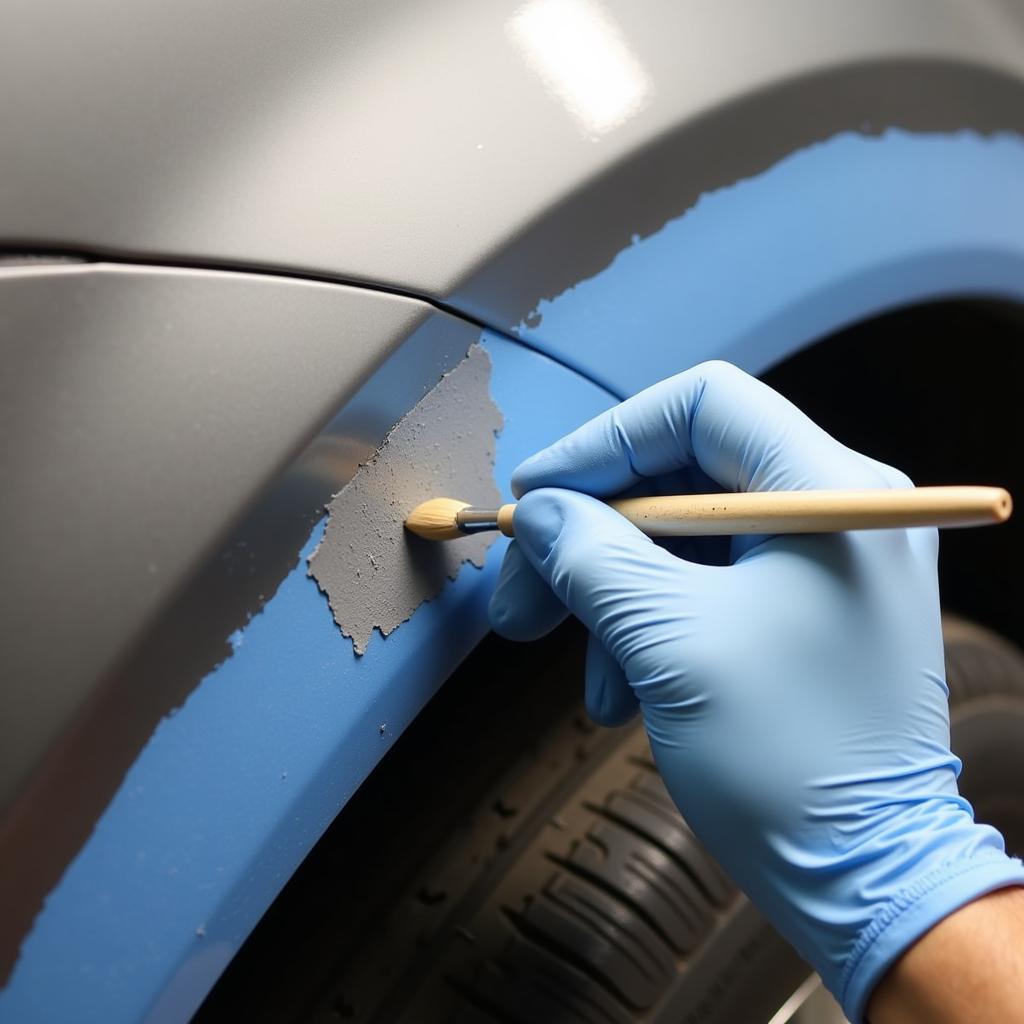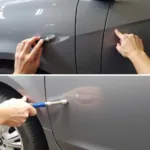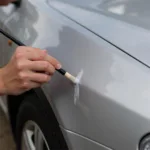Rust on your car’s paint is a common problem that, if left unchecked, can lead to serious damage. Addressing rust in its early stages is crucial for preserving your car’s appearance and value. This guide provides a comprehensive approach on how to repair the beginning of rust on car paint, offering practical tips and expert advice to help you tackle this issue effectively.
Identifying the Early Signs of Rust
Before diving into the repair process, it’s vital to recognize the initial indicators of rust. Look out for small, reddish-brown spots on your car’s paint, often appearing as blisters or bubbles. These spots might be concentrated around areas prone to moisture accumulation, such as wheel wells, door edges, and the lower portions of the car body. Discoloration or a slight rough texture around these spots further suggests the presence of rust.
Gathering Your Rust Repair Toolkit
Having the right tools ensures a smooth and effective repair process. Your rust repair kit should include: sandpaper (various grits, from coarse to fine), masking tape, primer specifically designed for metal, automotive touch-up paint that matches your car’s color, clear coat sealant, rubbing compound, and a polishing cloth. You’ll also need safety equipment like gloves and eye protection.
Essential Supplies for Rust Repair
- Sandpaper (180, 320, and 2000 grit)
- Masking tape
- Metal primer
- Automotive touch-up paint
- Clear coat sealant
- Rubbing compound
- Polishing cloth
- Gloves
- Eye protection
Step-by-Step Guide to Repairing Surface Rust
- Clean the Affected Area: Thoroughly wash the rusted area with soap and water, then dry it completely. This removes dirt and debris, allowing for better adhesion of the repair materials.
- Sand the Rust: Using 180-grit sandpaper, carefully sand the rusted area until the rust is completely removed and you reach bare metal. repair car paint scratches to the metal This crucial step stops the rust from spreading further beneath the paint.
- Feather the Edges: After removing the rust, use 320-grit sandpaper to feather the edges of the sanded area, creating a smooth transition between the bare metal and the surrounding paint.
- Apply Primer: Apply a thin, even coat of metal primer to the sanded area. Primer protects the bare metal from further corrosion and provides a better surface for the paint to adhere to. Allow the primer to dry completely according to the manufacturer’s instructions.
- Apply Touch-Up Paint: Once the primer is dry, apply thin coats of touch-up paint to the primed area, allowing each coat to dry before applying the next. paint chipping on car repair Build up the paint until it’s level with the surrounding paintwork.
- Apply Clear Coat: After the touch-up paint has dried, apply a few thin coats of clear coat sealant to protect the paint and give it a glossy finish.
- Sand and Polish: Once the clear coat is dry, use 2000-grit sandpaper to wet sand the repaired area, smoothing out any imperfections. Follow this with rubbing compound and a polishing cloth to achieve a flawless finish.
 Applying touch-up paint to a car's rusted area
Applying touch-up paint to a car's rusted area
Preventing Future Rust Formation
Regular washing and waxing can help prevent rust. how to repair paint scratch on car Keeping your car clean and protected with a layer of wax helps repel water and other elements that contribute to rust formation. Regularly inspecting your car for early signs of rust is also important.
“Addressing rust at its initial stages is far more effective and less expensive than dealing with extensive rust damage later on,” says automotive expert, Michael Davies.
When to Seek Professional Help
While minor surface rust can be tackled with DIY methods, extensive rust or rust that has penetrated deep into the metal requires professional attention. car painting and dent repair in surprise az A professional can assess the extent of the damage and employ advanced techniques like sandblasting or welding to restore your car’s body.
“Don’t underestimate the insidious nature of rust. What starts as a small spot can quickly escalate into a significant problem if left untreated,” warns Sarah Miller, a veteran car repair specialist.
Conclusion
Repairing the beginning of rust on your car’s paint is a manageable task when addressed promptly. By following the steps outlined in this guide and employing preventative measures, you can keep your car looking its best and protect its value. car paint repair darlington Early intervention is key to preventing minor rust issues from developing into major, costly repairs.
FAQ
- What causes rust on car paint? Exposure to moisture, road salt, and air pollutants can cause the metal underneath the paint to oxidize, leading to rust.
- Can I use any type of primer for rust repair? No, it’s crucial to use a primer specifically designed for metal to ensure proper adhesion and corrosion protection.
- How many coats of touch-up paint should I apply? Apply thin coats, allowing each coat to dry before applying the next, until the paint is level with the surrounding paintwork.
- Do I need to apply clear coat after touch-up paint? Yes, clear coat protects the paint and provides a glossy finish.
- How can I prevent rust from forming on my car? Regular washing, waxing, and inspections can help prevent rust formation.
Need assistance with your car repair? Contact us via WhatsApp: +1(641)206-8880 or Email: [email protected]. Our customer service team is available 24/7.


